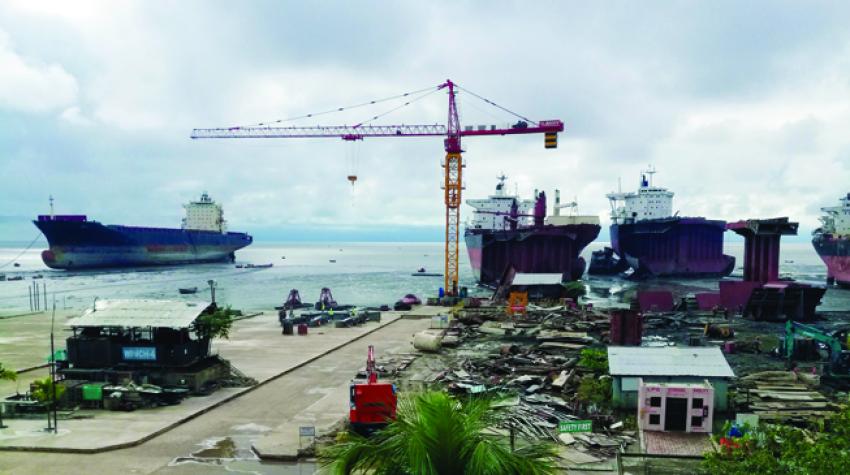Governments are set to agree to boost the global shipping sector’s emissions reduction targets, at talks in London this week.
After a week of behind closed door negotiations, the talks chair put together a draft strategy on Monday which includes improved emissions cut targets for 2030, 2040 and 2050.
The strategy aims for the sector to reach net zero either “by” or “around” 2050 and targets emissions cuts on 2008 levels of 20 percent by 2030 and 70 percent by 2040.
The document has yet to be approved, is subject to change and is less ambitious than some governments and environmental groups are calling for – but it’s a clear step up in ambition from the sector’s current goals.
In 2018, governments’ shipping negotiators agreed to cut emissions in half on 2008 levels by 2050 – despite concerns that the target was too ambitious from nations like Brazil, India, Saudi Arabia and Donald Trump’s USA.
On the other hand, campaigners called for full decarbonisation by 2050 and, as support has grown in the intervening years, now look likely to get their wish.
The draft strategy document commits shipping to reach net zero greenhouse gas emissions either “by 2050 at the latest” or “by or around 2050”.
That second, weaker target could include language around “different national circumstances”, which would give more leeway to developing countries.
In their speeches to the International Maritime Organisation (IMO) talks this week, the “2050 at the latest” goal was supported mainly by Pacific islands and developed countries.
The UK’s negotiator said 2050 should be “the absolute latest” and that the targets should be “in terms that can not be misunderstood”. IMO rules prohibit directly naming negotiators.
On the other hand, several big developing countries like China, Indonesia and Saudi Arabia called for the weaker “around 2050” target and the inclusion of language about “different national circumstances”.
Saudi Arabia’s representative called for a “flexible and adaptable approach” while China’s said that shipping enabled economic growth which gave the world more money to spend battling climate change.
While supporting a 2050 net-zero goal, several negotiators echoed Costa Rica’s in saying that alone is “not enough” and that interim targets are necessary.
The sector currently has no 2030 or 2040 targets and its emissions are expected to keep rising, unless it changes its ways.
The draft strategy includes a emissions cut target of 20 percent for 2030 and 70 percent by 2040, on 2008 levels. These could be supplemented by an agreement to “striv[e] for” 25 percent and 75 percent respectively.
Both targets are less than what the European Union, USA, UK, Pacific islands and others were calling for and less than what the Science-Based Targets Initiative say is aligned with 1.5C of global warming.
Australia’s negotiator said they were “not ambitious enough” and “the world is watching – more than I’ve ever seen it watching”.
The Marshall Islands negotiator Albon Ishoda told journalists that “the science already told us” that “anything less than 36 percent by 2030 and 96 percent by 2050 will be detrimental” to limiting global warming to 1.5C and that will “have a devastating impact”.
But, sources involved in last week’s closed talks, said some countries like China, South Africa and Saudi Arabia didn’t want 2030 or 2040 targets at all.
The talks chair, Liberian diplomat Harry Conway, told Climate Home he would look for options that could gain consensus among nations.
Conway said he would “strive as much as possible to avoid votes” but member states can choose to call a vote, although they rarely do.
Vanuatu’s negotiator Ralph Regenvanu told a press briefing that they would think about calling a vote if a “minority group of countries” were going to stop a “high ambition outcome” against the will of an “overwhelming majority, and I mean like two-thirds”.
The draft deal contains a target to get “zero or near-zero” sources to represent 5 percent of the energy used by international shipping by 2030. This target could be strengthened by the words “at least” and “striving for 10 percent”.
Shipping is currently powered almost completely by fossil fuels. According to the International Energy Agency (IEA), “low-carbon fuels” represent near to 0 percent of shipping’s fuel.
Discussions on how to reduce emissions have proven more contentious, with several big emerging economies, led by Brazil, resisting a proposal to tax shipping emissions and use the money to clean up the sector.
All these targets will be debated by negotiators at the IMO’s marine environment protection committee until they come to a decision on Friday.
Asked if he thought the 2030 and 2040 targets would improve, Regenvanu told Climate Home he was “going to fight” for improved targets. “That’s what we’re here for, we’re here to lobby”, he said.
SOURCE: CLIMATE HOME/PACNEWS














